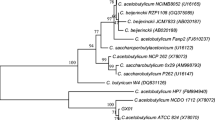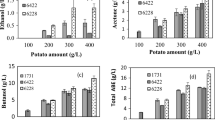Abstract
Cassava cultivation is cheap, with potential development under different climatic conditions. It is cultivated mainly in South America, Asia, and Africa. Cassava starch is an attractive feedstock, and has been employed as carbon source for production of butanol given its low cost and wide availability. In this sense, this study aimed to evaluate the production of butanol by Clostridium acetobutylicum DSMZ 792 using cassava starch as a substrate, applying Design of Experiments (DoE). Key parameters reported in the literature, such as pH and substrate concentration, were used in the evaluation trials by DoE using Rotatable Central Composite Design (RCCD) on butanol production during fermentation of cassava starch. This evaluation employed RCCD, which is a factorial scheme of treatment (22) considering four factorial design points (T1-T4), four axial points (T5-T8), and three replications on the central points (T9-T11), totaling 11 experiments. Fermentation was conducted in batch mode in 500 mL flasks, containing effective reaction volume of 300 mL. Concentrations of butanol, acetic and butyric acids were separated and analyzed by High-Performance Liquid Chromatography (HPLC) using a column (300 mm × 7.8 mm). Data were collected and analyzed using Class-VP software. The RCCD indicated that the highest butanol production is achieved in tests performed with higher concentration of the glucose, i.e., 50.0 g L−1 and with initial pH 5.7, resulting in a butanol concentration of 4.37 g L−1. The results showed that butanol production was dependent on butyric acid re-assimilation. DoE is a powerful tool for obtaining the optimum butanol concentration for determined operation condition.
Similar content being viewed by others
References
Al-Shorgani NKN, Kalil MS, Yusoff WMW (2011) The effect of different carbon sources on biobutanol production using Clostridium saccharoperbutylacetonicum N1–4. Biotechnol 10:280–285
Al-Shorgani NKN, Shukor H, Abdeshahian P, Nazir MYM, Kalil MS, Hamid AA, Yusoff WM (2015) Process optimization of butanol production by Clostridium saccharoperbutylacetonicum N1–4 (ATCC13564) using palm oil mill effluent in acetone–butanol–ethanol fermentation. Agric Biotechnol 4:244–249
Al-Shorgani NKN, Kalil MS, Yusoff WMW, Hamid AA (2018) Impact of pH and butyric acid on butanol production during batch fermentation using a new local isolate of Clostridium acetobutylicum YM1. Saudi J Biol Sci 25:339–348
Ayetigbo O, Latif S, Abass A, Müller J (2018) Comparing characteristics of root, flour and starch of biofortified yellow-flesh and white-flesh cassava variants, and sustainability considerations: a review. Sustainability 10:3089. https://doi.org/10.3390/su10093089
Baghchehsaraee B (2009) Batch and continuous biohydrogen production using mixed microbial culture. Dissertation. The University of Western Ontario, Canada
Buehler EA, Mesbah A (2016) Kinetic study of acetone–butanol–ethanol fermentation in continuous culture. PLoS ONE 11:1–21. https://doi.org/10.1371/journal.pone.0158243
Cappelletti BM, Reginatto V, Amante ER, Antônio RV (2011) Fermentative production of hydrogen from cassava processing wastewater by Clostridium acetobutylicum. Renew Energy 36:3367–3372
Cheng C, Bao T, Yang ST (2019) Engineering Clostridium for improved solvents production: recent progress and perspective. Appl Microbiol Biotechnol 103(14):5549–5566. https://doi.org/10.1007/s00253-019-09916-7
Chinma CE, Ariahu CC, Abu JO (2013) Chemical composition, functional and pasting properties of cassava starch and soy protein concentrate blends. J Food Sci Technol 50:1179–1185
Chogi MAN, Araujo ACV, Prado PF, Silva DB, Silva AJ, Silva GF, Duarte ICSD (2020) Production of biofuel and organic acids for adding value to cassava wastewater. Rev Virtual Quim 12(1):89–98. https://doi.org/10.21577/1984-6835.20200009
Crespo CF, Badshah M, Alvarez MT, Mattiasson B (2012) Ethanol production by continuous fermentation of D-(+)-cellobiose, D-(+)-xylose and sugarcane bagasse hydrolysate using the thermoanaerobe caloramator boliviensis. Bioresour Technol 103:186–191. https://doi.org/10.1016/j.biortech.2011.10.020
Dwidar M, Park JY, Mitchell RJ, Sang B (2012) The future of butyric acid in industry. Sci World J. https://doi.org/10.1100/2012/471217
Ebraim E, Amiri H, Asadollahi MA (2020) Enhanced aerobic conversion of starch to butanol by a symbiotic system of Clostridium acetobutylicum and Nesterenkonia. Biochem Eng J. https://doi.org/10.1016/j.bej.2020.107752
Ezeji T, Qureshi N, Blaschek HP (2007) Bioproduction of butanol from biomass: from genes to bioreactors. Curr Opin Biotechnol 18:220–227
Gottumukkala LD, Haigh K, Görgens J (2017) Trends and advances in conversion of lignocellulosic biomass to biobutanol: microbes, bioprocesses and industrial viability. Renew Sustain Energy Rev 76:963–973. https://doi.org/10.1016/j.rser.2017.03.030
Hergueta C, Bogarra M, Tsolakis A (2017) Butanol-gasoline blend and exhaust gas recirculation, impact on GDI engine emissions. Fuel 208:662–672
Hiral S, Abhishek M, Aruna GA, Annamma AO, Arvind L (2017) Enhanced acidogenic by the degenerated Clostridium sp. strain on a continuous membrane cell recycle reactor. Adv Biotechnol Microbiol. https://doi.org/10.19080/AIBM.2017.07.555716
Huang J, Du Y, Bao T, Lin M, Wamg J, Yang ST (2019) Production of n-butanol from cassava bagasse hydrolysate by engineered Clostridium tyrobutyricum overexpressing adhE2: kinetics and cost analysis. Biores Technol. https://doi.org/10.1016/j.biortech.2019.121969
Jang YS, Lee JY, Lee J, Park JH, Im JA, Eom MH, Lee J, Lee SH, Song H, Cho JH, Seung D, Lee SY (2012) Enhanced butanol production obtained by reinforcing the direct butanol-forming route in Clostridium acetobutylicum. Mbio 3(5):e00314-e412. https://doi.org/10.1128/mBio.00314-12
Jiang M, Chen JN, He AY, Wu H, Kong XP, Liu JL, Yin CY, Chen WF, Chen P (2014) Enhanced acetone/butanol/ethanol production by Clostridium beijerinckii IB4 using pH control strategy. Process Biochem 49:1238–1244
Johnravindar D, Elangovan N, Gopal NO, Muthaiyan A (2019) Biobutanol production from cassava waste residue using Clostridium sp. AS3 in batch culture fermentation. Biofuels. https://doi.org/10.1080/17597269.2019.1608671
Jones DT, Woods DR (1986) Acetone-butanol fermentation revisited. Microbiol Rev 50(4):484–524
Khamaiseh EI, Kalil MS, Hamid AA, Yusoff WMW (2011) Biobutanol production by Clostridium acetobutylicum NCIMB 13357 in modified medium using date fruit as a carbon source. In: Jordam international energy conference, Amman
Kolesinska B, Fraczyk J, Binczarski M, Modelska M, Berlowska J, Dziugan P, Antolak H, Kaminski ZJ, Witonska IA, Kregiel D (2019) Butanol synthesis routes for biofuel production. Trends Perspect Mater 12:350–371. https://doi.org/10.3390/ma12030350
Kumar M, Kumar D, Singh B (2014) Utilization of agro residue cornocob for production of acetone-butanol-ethanol using Clostridium acetobutylicum and process optimization through RSM. Microb Biochem Technol. https://doi.org/10.4172/1948-5948.S8-005
Kushwaha D, Srivastava N, Mishra I, Upadhyay SN, Mishra PK (2019) Recent trends in biobutanol production. Rev Chem Eng 35(4):475–504. https://doi.org/10.1515/revce-2017-0041
Lépiz-Aguilar L, Rodrígues-Rodríguez CE, Arias ML, Lutz G (2013) Acetone–butanol–ethanol (ABE) production in fermentation of enzymatically hydrolyzed cassava flour by Clostridium beijerinckii BA101 and solvent separation. J Microbiol Biotechnol 23:1092–1098. https://doi.org/10.4014/jmb.1301.01021
Li SY, Srivastava R, Suib SL, Li Y, Parnas RS (2011) Performance of batch, fed-batch, and continuous A-B–E fermentation with pH-control. Bioresour Technol 102(5):4241–4250. https://doi.org/10.1016/j.biortech.2010.12.078
Li J, Chen X, Qi B, Luo JZY, Su Y, Wan Y (2014) Efficient production of acetone–butanol–ethanol (ABE) from cassava by a fermentation–pervaporation coupled process. Bioresour Technol 169:251–257. https://doi.org/10.1016/j.biortech.2014.06.102
Li S, Guo Y, Lu F, Huang J, Pang Z (2015) High-Level butanol production from cassava starch by a newly isolated Clostridium acetobutylicum. Appl Biochem Biotechnol 177:831–841
Li HG, Zhang QH, Yu XB, Wei L, Wang Q (2016) Enhancement of butanol production in Clostridium acetobutylicum SE25 through accelerating phase shift by different phases pH regulation from cassava flour. Bioresour Technol 201:148–155
Lin Z, Liu H, Wu J, Patakova P, Branska B, Zhang J (2019) Effective continuous acetone–butanol–ethanol production with full utilization of cassava by immobilized symbiotic TSH06. Biotechnol Biofuels 12:219. https://doi.org/10.1186/s13068-019-1561-1
Luo W, Zhao Z, Pan H, Zhao L, Xu C, Yu X (2019) Feasibility of butanol production from wheat starch wastewater by Clostridium acetobutylicum. Energy 154:240–248. https://doi.org/10.1016/j.energy.2018.04.125
Lütke-Eversloh T (2014) Application of new metabolic engineering tools for Clostridium acetobutylicum. Appl Microbiol Biotechnol 98:5823–5837. https://doi.org/10.1007/s00253-014-5785-5
Mandenius CF, Brundin A (2008) Bioprocess optimization using design-of-experimental methodology. Review: biocatalysis and bioreactor design. Biotechnol Prog 24:1191–1203
Ndaba BMA, Chiyanuzu I, Marx S (2015) n-Butanol derived from biochemical and chemical routes: a review. Biotechnol Rep 8:1–9. https://doi.org/10.1016/j.btre.2015.08.001
Ozturk AB, Arasoglu T, Gulen J, Cheng S, Al-Shorgani NKN, Habaki H, Egashira R, Kalil MS, Yusoff WMW, Cross JS (2021) Techno-economic analysis of two-step fermentation process for bio-butanol production from cooked rice. Sustain Energy Fuels 5:3705–3718. https://doi.org/10.1039/d1se00496d
Parmar A, Sturn B, Hensel O (2017) Crops that feed the world: production and improvement of cassava for food, feed, and industrial uses. Food Secur 9:907–927. https://doi.org/10.1007/s12571-017-0717-8
Qi G, Xiong L, Luo M, Huang Q, Huang C, Li H, Chen X, Chen X (2018) Solvents production from cassava by co-culture of Clostridium acetobutylicum and Saccharomyces cerevisiae. J Environ Chem Eng 6(1):128–133. https://doi.org/10.1016/j.jece.2017.11.067
Qureshi N, Ezeji TC (2008) Butanol, ‘a superior biofuel’ production from agricultural residues (renewable biomass): recent progress in technology (review). Biofuels Bioprod Bioref 2:319–330. https://doi.org/10.1002/bbb.85
Ranjan A, Mayank R (2013) Process optimization for butanol production from developed rice straw hydrolysate using Clostridium acetobutylicum MTCC 481 strain. Biomass Convers Biorefinery J 3:143–155
Regestein L, Doerr EW, Staaden ARL (2015) Impact of butyric acid on butanol formation by Clostridium pasteurianum. Biores Technol 196:153–159
Research & Markets (2019) Cassava processing market report: industry tnds, share, size, growth, opportunity and forecasts 2011–2018 & 2019–2024
Saekhow B, Chookamlang S, Na-u-dom A, Leksawasdi N, Sanguanchaipaiwong V (2020) Enzymatic hydrolysis of cassava stems for butanol production of isolated Clostridium sp. Energy Rep 6(1):196–201. https://doi.org/10.1016/j.egyr.2019.08.042
Silva AJ, Pozzi E, Foresti E, Zaiat M (2014) The influence of the buffering capacity on the production of organic acids and alcohols from wastewater in anaerobic reactor. Appl Biochem Biotechnol 175:2258–2265. https://doi.org/10.1007/s12010-014-1424-y
Singh V, Yadav S, Sem R, Das D (2020) Concomitant hydrogen and butanol production via co-digestion of organic wastewater and nitrogenous residues. Int J Hydrogen Energy 45:24477–24490. https://doi.org/10.1016/j.ijhydene.2020.06.282
Strazzera G, Batista F, Garcia NH, Frison N, Bolzonella D (2018) Volatile fatty acids production from food wastes for biorefinery plataforms: a review. J Environ Manag 226:278–288. https://doi.org/10.1016/j.jenvman.2018.08.039
Swinnen IAM, Bernaerts K, Dens EJJ, Geeraerd AH, Van Impe JF (2004) Predictive modelling of the microbial lag phase: a review. Int J Food Microbiol 94:137–159. https://doi.org/10.1016/j.ijfoodmicro.2004.01.006
Thang VH, Kanda K, Kobayashi G (2010) Production of acetone-butanol-ethanol (ABE) in direct fermentation of cassava by Clostridium saccharoperbutylacetonicum N1–4. Appl Biochem Biotechnol 161(1–8):157–170. https://doi.org/10.1007/s12010-009-8770-1
Tran HTM, Cheirsilp B, Hodgson B, Umsakul K (2013) Biobutanol production from cassava starch by a co-culture of Clostridium butylicum and Bacillus subtilis: effect of batch and fed-batch fermentation with pH-control and in situ product recovery. J Biobased Mater Bioenergy 7:648–654
Veza I, Said MFM, Latiff ZA (2021) Recent advances in butanol production by acetone-butanol-ethanol (ABE) fermentation. Biomass Bioenerg 144:105919. https://doi.org/10.1016/j.biombioe.2020.105919
Visioli L, Enzweiler H, Kuhn RC, Schwaab M, Mazutti MA (2014) Recent advances on biobutanol production. Sustain Chem Process 2:15. https://doi.org/10.1186/2043-7129-2-15
Wadjeam P, Reungsang A, Imai T, Plangklang P (2019) Co-digestion of cassava starch wastewater with buffalo dung for bio-hydrogen production. Int J Hydrogen Energy 44:4694–4706. https://doi.org/10.1016/j.ijhydene.2019.04.138
Wang J, Wan W (2009) Experimental design methods for fermentative hydrogen production: a review. Int J Hydrog Energy 34:235–244
Weissman S, Anderson NG (2015) Design of experiments (DoE) and process optimization. A review of recent publications. Org Process Res Dev 19:1605–1633. https://doi.org/10.1021/op500169m
Whitford WF, Lundgren M, Fairbank A (2018) Cell culture media in bioprocessing. Development, design, and implementation of manufacturing processes. Biopharmaceut Process. https://doi.org/10.1016/B978-0-08-100623-8.00008-6
Yao P, Xiao Z, Chen C, LIW, Deng Q, (2016) Cell growth behaviors of Clostridium acetobutylicum in a pervaporation membrane bioreactor for butanol fermentation. Biotechnol Appl Biochem 63(1):101–105. https://doi.org/10.1002/bab.1318
Yin J, Yu X, Wang K, Shen D (2016) Acidogenic fermentation of the main substrates of food waste to produce volatile fatty acids. Int J Hydrogen Energy 41(46):21713–21720. https://doi.org/10.1016/j.ijhydene.2016.07.094
Acknowledgements
The authors thank Coordination for the Improvement of Higher Education Personnel (CAPES) for the fellowship granted to the first author, and Faepex/Unicamp and the São Paulo Research Foundation (Fapesp), process #2012/09785-8, for their financial support. We also thank Professor Adriano Pinto Mariano, from the Laboratory of Optimization, Projects and Advanced Control (LOPCA-FERM-UNICAMP), for donating the Clostridium acetobutylicum DSMZ 792 used in this study.
Author information
Authors and Affiliations
Corresponding author
Additional information
Publisher's Note
Springer Nature remains neutral with regard to jurisdictional claims in published maps and institutional affiliations.
Rights and permissions
About this article
Cite this article
da Silva, D.B., Fernandes, B.S. & da Silva, A.J. Butanol production by Clostridium acetobutylicum DSMZ 792 from cassava starch. Environmental Sustainability 5, 91–102 (2022). https://doi.org/10.1007/s42398-022-00218-9
Received:
Revised:
Accepted:
Published:
Issue Date:
DOI: https://doi.org/10.1007/s42398-022-00218-9













